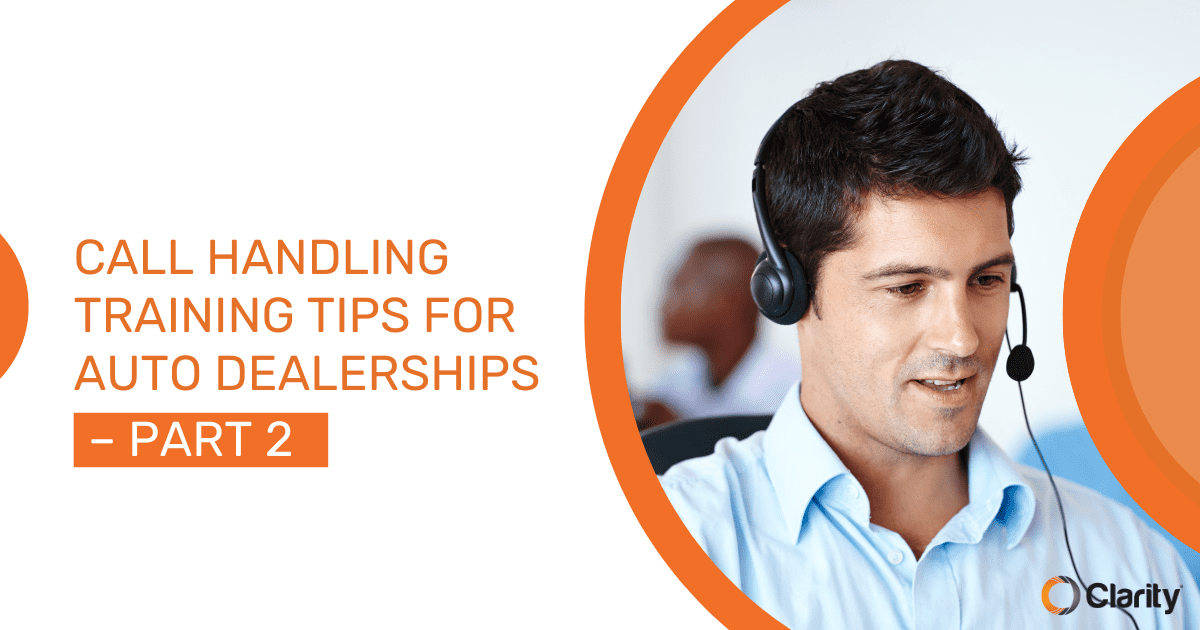Everyone knows how to answer a phone call. After all, we carry phones in our pockets and reach for them several times per day. However, our recent series of articles for auto dealerships cautions against skipping call handling training with your employees. So far, we’ve learned:
- Inbound phone calls to auto dealerships are on the rise.
- Yet 41.2 percent of qualified leads to auto dealerships are being mishandled.
- The problems include missed calls, long hold times, delayed follow-up, and not logging leads.
- You can solve these problems by following five inbound call handling principles.
Dealership employees don’t automatically know the principles of successful call handling. That’s why you must create a robust call handling training program to ensure they follow company procedures, offer exceptional service to callers, and nurture callers to become car buyers.
To review, the five principles of call handling are:
- Answering the call
- Understanding the caller’s needs
- Showing the value of your auto dealership
- Building a relationship with the caller
- Setting an appointment for the caller to come into the dealership
In Call Handling Training Tips for Auto Dealerships Part 1, we discussed tips for answering the call and understanding the caller’s needs. Today we will continue to the next two principles – showing value and building the relationship.
Call Handling Training Program: 5 Tips for Showing Value and Building Relationships
Check out this article for tips on answering the call and understanding the caller’s needs. Here we will elaborate on things you should include in your call handling training program to help your employees show value and build a relationship with the caller.
Tips for Showing Value
1. Educate Your Staff About Your Dealership

It is unfair to assume that new hires know all there is to know about your auto dealership. Your call handling training program should offer training about the dealership’s history, mission and values, differentiator, inventory, and any other information the call handler may need.
When everyone understands the business’s story, voice, and personality, customers will get a consistent experience, and employees will be able to communicate value on the call.
2. Value Must Be Tied to the Caller’s Needs
Another thing to emphasize in your call handling training program is that you can’t ‘push’ value on the caller.
Sure, you may have the finest inventory of Lexus vehicles in the state, but if the caller is not interested, the information shared will be perceived as pushy and potentially rude—not valuable.
This tip goes back to the importance of understanding the caller’s needs, which we covered in Part 1 of this series. The value offered must be directly related to the caller’s inquiry for it to be perceived as valuable by the caller.
3. Value Differs Based on Car Buyer Persona

The value must be related to what the caller has already asked for or discussed on the call. However, Caller A and Caller B may have called about the same thing, but the way to show value for each caller may be different. The reason is that there are various car buyer personas:
- The Decided Buyer knows exactly what they want and has typically done extensive research on one or two specific vehicles. Showing value for this personality means getting down to business and sharing specific data to drive their decision home.
- The Cross-Buyer will take their time browsing and researching every option. To show value for this personality, you’ll want to provide information in a clear and organized way to help them feel comfortable and confident in making a decision.
- The Undecided Buyer doesn’t know what they want and hasn’t done much research either. To show value, you’ll want to spend time getting to know them, establishing trust, and then offering suggestions based on what you’ve learned.
- The Bargain Buyer wants to get the lowest price possible and may use aggressive negotiation tactics. To show value, you’ll want to balance features with affordability (but don’t negotiate over the phone; get them to come into the dealership for that discussion).
Understanding car buyer personas is important for all interactions with potential car buyers. Still, it’s important to include in your call handling training program because employees must be trained to recognize each persona based on conversation alone (versus other visual clues one would have if the person were present in the dealership).
Tips for Building a Relationship
4. Focus on the Caller

The key to building a relationship with a caller is to make them feel valued and to keep the emphasis on them. If you follow the tips we shared in Part 1 of this series, you’ll be well on your way to building a solid relationship. This includes:
- Asking their name and using it during the call
- Speaking in a positive, enthusiastic tone (smile while you talk—the caller will be able to hear it!)
- Asking good questions (and follow-up questions) to understand the caller and his or her needs
- Practicing active listening skills
- Showing empathy, which is understanding and acknowledging how the person may be feeling, not just the facts they give
Building rapport is tricky, but the good news is that a person’s skills can grow over time. Your call handling training program should include ways to evaluate these relationship-building aspects of the call so you (or another manager) can provide employees with feedback.
Call recording is an excellent way to do this. Clarity Voice DealerPhones includes the tools you need to record calls, listen to live calls, and even join an employee in ‘whisper’ mode.
5. Train Employees to Use the CRM
The goal of building a relationship should extend beyond the initial call. That’s why you’ll want to log all inbound calls in your CRM so you can follow up in the future and so important details are at everyone’s fingertips. For this reason, your call handling training program should include training on how to use the CRM and what information you want employees to log.

Creating a Call Handling Training Program
Teaching your employees to show value and build a relationship with the caller are two main focuses of any effective call handling training program.
Pair these tips with our advice on answering the call and understanding the caller’s needs (in Part 1 here), and you’ll be well on your way to creating an effective training program.
However, arguably the most important principle for handling inbound calls is setting the appointment. We’ll cover this important topic in our next article.



